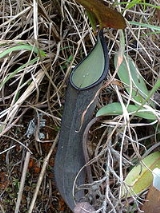
Nepenthes ramispina
Encyclopedia
Nepenthes ramispina is a highland Nepenthes
pitcher plant
species, native to Peninsular Malaysia
. It is very similar to N. gracillma
and there is much debate about whether the two should be treated as separate species.
Nepenthes
The Nepenthes , popularly known as tropical pitcher plants or monkey cups, are a genus of carnivorous plants in the monotypic family Nepenthaceae. The genus comprises roughly 130 species, numerous natural and many cultivated hybrids...
pitcher plant
Pitcher plant
Pitcher plants are carnivorous plants whose prey-trapping mechanism features a deep cavity filled with liquid known as a pitfall trap. It has been widely assumed that the various sorts of pitfall trap evolved from rolled leaves, with selection pressure favouring more deeply cupped leaves over...
species, native to Peninsular Malaysia
Peninsular Malaysia
Peninsular Malaysia , also known as West Malaysia , is the part of Malaysia which lies on the Malay Peninsula. Its area is . It shares a land border with Thailand in the north. To the south is the island of Singapore. Across the Strait of Malacca to the west lies the island of Sumatra...
. It is very similar to N. gracillma
Nepenthes gracillima
Nepenthes gracillima is a highland Nepenthes pitcher plant species, native to Peninsular Malaysia.-Infraspecific taxa:*Nepenthes gracillima f. ramispina Hort.Westphal [=N. ramispina]...
and there is much debate about whether the two should be treated as separate species.
Natural hybrids
- N. macfarlaneiNepenthes macfarlaneiNepenthes macfarlanei is a carnivorous pitcher plant species endemic to Peninsular Malaysia. It produces attractive red-speckled pitchers. Lower pitchers are ovoid to cylindrical and up to 20 cm high. The lower surface of the lid is densely covered with short, white hairs...
× N. ramispina - N. ramispina × N. sanguineaNepenthes sanguineaNepenthes sanguinea is a large and vigorous Nepenthes pitcher plant species, native to the Malay Peninsula, where it grows at 900–1800 m altitude. The pitchers are variable in size, from 10–30 cm tall, and range from green and yellow to orange and red. The insides of the pitchers are usually...

